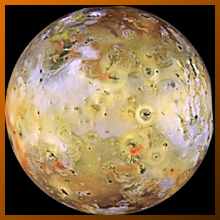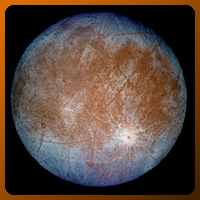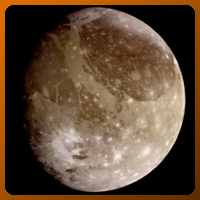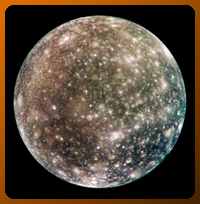You are seeing this message because you are using an out-of-date browser.
Please click here for more information.
The Moons of Jupiter
As the largest planet in our solar system, it is only fitting that Jupiter
also has the largest number of moons. At last count, Jupiter has a total of
sixty-one moons, ranging from tiny "moonlets" only a few miles in diameter
up to giant Ganymede, which is larger than two of the planets in the solar
system. The four largest moons are called the Galilean moons because they
were discovered by Galileo Galilei when he started using his primitive
telescope almost five hundred years ago.

Image courtesy of: JPL/Galileo Mission
Io is the closest Galilean moon of Jupiter. This small (2178 miles in diameter) moon, is a little larger than our own Moon, but has a much more active life than the Moon of Earth. Io is constantly being expanded and contracted by the gravitational pull of Jupiter, Europa and Ganymede. The continuous tugging on the small moon has many effects, some of which we are just beginning to understand. First of all, the constant expansion and contraction generates a lot of heat on and within the moon. Second, the constant flexing of the surface actually cracks the surface of Io and may eventually break the small moon into pieces. Third the cracks in the surface probably play a part in the almost constant volcanic eruptions we now know are part of everyday life on Io. These eruptions also mean that the surface of Io is regularly changed by the flows from the volcanic eruptions. The eruptions make "lakes" of molten lava. In addition, there appear to be other "lakes" on the surface of the planet that we aren't able to explain fully. All in all, Io is a very mysterious place.

Image courtesy of: JPL/Voyager Mission

Image courtesy of: JPL/Galileo Mission
The Galileo mission to Jupiter has sent back enough information about Jupiter and its moons to keep scientists busy for years to come. One of the most exciting pieces of news from this lengthy mission has been the discovery of a watery, liquid ocean under the icy surface of this Galilean moon, which is just a little smaller (1882 miles in diameter) than Earth's Moon.
All that we really knew before was that Europa, the second of the Galilean moons, was a frozen world with many interesting patterns on its icy surface. The discovery of the subsurface ocean has scientists around the world excited, and there are preliminary plans on the works now to send another mission to explore this small moon. There is even a small chance that some form of life manages to survive in the submerged ocean. Only further research will give us the final answer.

Image courtesy of: JPL/Galileo Mission
The third Galilean moon is not only the largest (3157 miles in diameter) moon of Jupiter, it is the largest moon in the solar system and is actually larger than the planets Mercury and Pluto. By comparison, our own Moon is about 2085 miles in diameter.
Ganymede is another example of the wealth of information sent back by the Galileo mission. The spacecraft has told us that this giant moon has a very liquid iron core, surrounded by a large layer of material that probably is some kind of silicon-based substance with a thin outer layer of ice. You could kind of think of it as a giant M & M candy, except it probably wouldn't be very good to eat. The giant moon also has many craters, much like our own Moon, but the craters are, mysteriously, not very deep and appear to be smoothed out, as opposed to the craters on our Moon.
The Galileo mission has also taught us that, at one time, there were active volcanoes on Ganymede, but there are no volcanoes now. The giant moon also has fault lines, like the famous San Adreas fault in California. The lines tell us that at one time the moon's surface was flexing and changing like Io's does now, although that activity seems to have come to a stop. This shows once again that the more you learn, the more questions there are.

Image courtesy of: JPL/Galileo Mission
The last of the Galilean moons of Jupiter is Callisto. In keeping with the tradition of the other Galilean moons, Callisto offers us other mysteries to ponder. Although Callisto appears to be nothing more than a heavily cratered moon, much like our own Moon, the Galileo mission has uncovered hints of what may be an ocean lurking beneath its cold surface. Is there actually another moon of Jupiter with a subterranean ocean? Only further exploration will tell us for sure. With a diameter of 2880 miles, Callisto is quite a bit larger than our own Moon, but is still much smaller than giant Ganymede.
The surface of Callisto also has many more craters than Ganymede, and although the craters appear to be very ancient, they aren't as smooth as the ones on Ganymede, so the icy surface of Callisto doesn't appear to be as "active" as the one on Ganymede. How Ganymede and Callisto could appear to be so different is another mystery that scientists are trying to solve.
A List of Jupiter's Moons
Here is a list of all the named moons of Jupiter. Although the planet has 39 moons that we
know about, not all of them have names yet. This list is just the ones that are "lucky"
enough to have been named. They are in order from the closest to the furthest away
from Jupiter. The distances of most of these moons from Jupiter should give you an
even better idea of the size of the planet and it's accompanying moon system.
Metis - Only about 24 miles in diameter, this moon orbits Jupiter from a distance
of 76,800 miles
Adrastea - Tiny, about 12 miles in diameter, Adrastea circles Jupiter from about
77,400 away.
Amalthea - This small moon, 118 miles in diameter, was a target of the Galileo
spacecraft on it's final pass around Jupiter. It is about 108,000 miles away from the
planet.
Thebe - Sixty miles in diameter, this moon orbits Jupiter from a distance of
133,200 miles.
Io - The first of the Galilean moons, Io is still as far away from Jupiter,
253,200 miles, as our Moon is from Earth
Europa - Europa orbits Jupiter from a distance of 402,000 miles.
Ganymede - Ganymede is 642,000 miles away from Jupiter.
Callisto - Callisto orbits Jupiter from a distance of 1,129,800 miles, or
more than four times the distance from Earth to our Moon.
Leda - Not quite ten miles in diameter, this tiny moon is 6,656,400 miles away
from Jupiter.
Himalia - A little over 51 miles in diameter, this moon orbits Jupiter from a
distance of 6,888,000 miles.
Lysithea - This twenty-two miles in diameter moon is a little over 7,000,000
miles away from Jupiter.
Elara - This moon is a little under 46 miles in diameter and orbits Jupiter from
a distance of 7,042,200 miles.
Ananke - This tiny moon, eighteen miles in diameter, orbits Jupiter from
a distance of 12,720,000 miles.
Carme - This moon is a little over 24 miles in diameter and orbits Jupiter from
a distance of 13,560,000 miles.
Pasiphea - This thirty miles in diameter moon orbits Jupiter from a distance
of 14,100,000 miles.
Sinope - This twenty-two miles in diameter moon orbits Jupiter from a distance of
14,220,000 miles.

